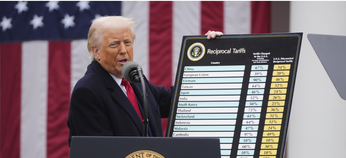
Geopolitical tensions fade
Hello! This week our top story is an analysis of why strained relations between Russia and the U.S. appeared to ease, and what the two sides were trying to get out of an escalation. We also look at what might happen now top independent media outlet Meduza has been labelled a ‘foreign agent’, and we profile secretive grocery store chain Svetofor that recently became Russia’s fastest growing retailer.

Crisis recedes as Russia pulls back troops, Navalny ends hunger strike
Fears of a geopolitical showdown faded this week as Russian troops withdrew from the Ukrainian border, opposition leader Alexei Navalny said he was stopping his hunger strike and President Vladimir Putin’s annual state-of-the-nation address was notably light on saber-rattling. In the space of just three days tensions that had been building for months appeared to dissipate.
What’s going on?
Putin gave his annual state-of-the-nation address Wednesday and many were expecting a sensation: perhaps a formal recognition of the rebel republics in Eastern Ukraine or an announcement Russia would formally unite with neighboring Belarus. However, there was almost no drama: Putin didn’t even mention Ukraine and devoted barely five minutes to foreign policy. The main topic was social handouts.
The same evening there was an unsanctioned rally in support of Navalny, with people in several cities taking to the streets. In Moscow — in sharp contrast with similar protests in January and February — everything went off peacefully, and there were just 20 arrests.
The following day, Defense Minister Sergei Shoigu announced an end to military training exercises on the Ukrainian border and the return of troops to their bases. The number of Russian soldiers massed near Ukraine had reached menacing levels: somewhere between 80,000 (a Ukrainian estimate) to 100,000 (the figure given by European Union officials).
Navalny’s doctors announced late Thursday that the opposition leader had received a visit from an independent medic and confirmed his condition (after more than three weeks on hunger strike) was life-threatening. Navalny said the next day that he would halt his hunger strike.
The markets responded with significant gains to this positive news. Since Thursday the ruble has risen 2.5 percent against the greenback, strengthening past 75 ruble against the dollar for the first time since the end of March.
Making sense of events
If you look at a timeline of the last couple of months, it suggests that the beginning of the latest round of geopolitical confrontation coincided with the start of Navalny’s prison term (he was sent to a penal colony on Feb. 25) and President Joe Biden’s first significant moves in respect of Russia: imposing sanctions over Navalny’s poisoning on March 2 and describing Putin as a murderer two weeks later. It was also around this time that Russia began moving troops toward its border with Ukraine.
When tensions along the Ukrainian border were at their height in early April, The Bell asked analysts about the possibility of war breaking out – but they all agreed that this was unlikely. Instead, the timeline suggests Russia was attempting to give itself a bargaining chip in negotiations with the West.
March 2 — the U.S. imposes sanctions on Russia for the 2020 nerve agent poisoning of Navalny.
March 5 — Bloomberg reports on preparations for new sanctions to target Russian state debt
March 16 — U.S. intelligence publishes a report on Russian interference in the 2020 presidential election and a CNN source claims sanctions could be imposed within a week
March 17 — Biden answers in the affirmative to a question about whether Putin is a murderer. The ruble starts a fall that will last for three consecutive weeks
March 30 — The Ukrainian military announces Russia is massing troops on its border
April 5 — Putin’s spokesperson Dmitry Peskov says Putin’s state-of-the-nation address will be on April 21. Theories about an escalation in Eastern Ukraine begin to swirl
April 8 — A senior Kremlin official says a military conflict would be “the beginning of the end” for Ukraine
April 13 — Biden calls Putin to discuss Ukraine and Navalny, and suggests a face-to-face meeting
April 15 — the U.S. imposes new sanctions on Russia. They do not pose any serious problem for the economy or the government’s fiscal plans. Biden gives a speech and talks of de-escalation
April 17 — Russia responds to U.S. sanctions. The most serious move is a ‘recommendation’ the U.S. ambassador returns to Washington. Preparations continue for a Putin-Biden summit
April 20 — Independent doctors visit Navalny in prison
April 21 — Putin gives his state-of-the-nation address and barely mentions foreign affairs
April 22 — Shoigu announces Russian troops will leave the Ukrainian border area
April 23 — Navalny ends his hunger strike
Why the world should care
These events look a lot like an effort by the Kremlin to test the new U.S. administration and we will soon find out how effective this has been: on June 2, the White House is due to impose a second round of sanctions. The only positive on the horizon is the upcoming meeting between Putin and Biden, but — at least for the moment — most analysts struggle to see much scope for meaningful progress.
‘Foreign agent’ label hits top independent media outlet Meduza
The authorities are stepping up their attack on independent media. The Ministry of Justice announced Friday that Meduza, Russia’s most popular independent media outlet, will be designated a ‘foreign agent’ (a Soviet-era term implying espionage). Theoretically, this has no impact. However, in reality, it limits Meduza’s ability to share articles on social media and could lead to a fall in advertising revenue.
- Legislation allowing media outlets to be designated as ‘foreign agents’ came into force in 2017 and was beefed up two years later. Until now, the ‘foreign agents list’ has only included publications officially financed by foreign governments like the U.S. funded Voice of America and Radio Free Europe/Radio Liberty. Meduza is the first major independent outlet on the list.
- From now on, Meduza will be obliged to preface all its articles and social media posts with a capitalized paragraph of text. On a smartphone, this takes up seven lines of the screen. From now on, Meduza’s Facebook posts will look like this:

- Theoretically, it’s not just Meduza who is affected: anyone who shares a link to a Meduza story is now supposed to refer to the media outlet’s ‘foreign agent’ status. If not, that individual can also be deemed a ‘media foreign agent’ (although this procedure has not yet been tested in court).
- If it breaks the rules, Meduza faces a fine of up to 5 million rubles ($67,000). Repeat violations would see the publication blocked in Russia. Readers who share Meduza articles without the relevant warning can be fined up to 2,500 rubles ($35), while other media outlets that re-post stories could be forced to pay up to 50,000 ($800). Radio Liberty/Radio Free Europe, a ‘foreign agent’ since 2017, has already incurred 19 million rubles ($253,000) in fines.
- But the biggest blow for Meduza is likely to be loss of advertising. Officially, there is no ban on advertising with a foreign agent, but any Russian company is likely to be nervous of such an association. In particular, companies doing business with the state will see it as a red flag. Advertising currently provides Meduza with the bulk of its revenue and Galina Timchenko, Meduza’s founder and CEO, told The Bell that she could not rule out financial problems.
- The most popular independent publication in Russia, Meduza was set-up by journalists from Lenta.ru who lost their jobs for political reasons after Russia’s 2014 annexation of Crimea. Meduza calculates its monthly readership is 13.9 million people.
Why the world should care
The Russian government has spent several years building a legislative arsenal that enables it to stifle any inconvenient media outlet – we are now seeing these weapons put to serious use for the first time.
Meet the Siberian brothers who built a ‘cut-price Walmart’
Even today, there are huge Russian companies about which there is almost no public information. This week, The Bell published a long article telling the story of one of them: a Russian Walmart copy-cat known as Svetofor. With 2020 revenue of about $2.5 billion, this Siberian company recently became Russia’s fastest-growing supermarket chain.
- “When I first ran into [the owners of Svetofor] it drove me fucking nuts that they were so secretive,” said one veteran of the retail market. “I liked the concept and tried to set up a meeting through some mutual acquaintances. Nobody even called me back! That’s not how we do things in retail. Everyone talks to each other.”
- The mysterious owners of Svetofor, who never give interviews, are Sergei and Andrei Schneider — two brothers from a family of German origin. They founded the company in 2009 when it seemed the leaders in Russian retail were unassailable. But Svetofor was very successful at copying the Western discount store format and managed to create a retail chain where prices were at least 20 percent lower than its main rivals.
- Like everyone in Russian retail, the Schneiders’ model was Walmart in the U.S. and Germany’s Aldi and Lidl. But Svetofor went further. A typical Svetofor store is a 1,500 square meter concrete box in a grimy city suburb, stacked from floor to ceiling with pallets of ultra-cheap goods.
- The chain will go to any lengths for low prices (for example, buying up goods close to their expiration date) and opens stores in places that other supermarkets won’t go. The Schneiders assumed shoppers would come to them if the price was right – and it was.
- Steadily falling salaries in Russia have been one of the key reasons behind Svetofor’s success, pushing shoppers into low cost stores. It has also forced Russia’s undisputed retail market leaders – X5 Retail Group and Magnit – to enter the budget sector. Both announced the launch of their own discount chains — Chizhik and My Price respectively — last year.
Why the world should care
Svetofor’s story is a perfect illustration of the state of the Russian economy. Now, Svetofor is going global (it can already be found in Germany, Latvia, Lithuania, Estonia, Poland, and Serbia). Future expansion is planned for Spain, France, Greece and even the U.S. and the United Kingdom.



PAID SUBSCRIPTION LAUNCH
From May 1, 2025, The Bell in English will no longer be free
From May 1, 2025, all The Bell’s newsletters and online content will be behind a paywall. We have taken this decision so that The Bell can remain financially independent, and maintain our high standards of journalism and economic expertise






